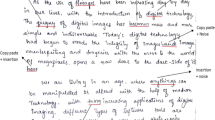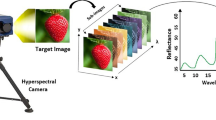Abstract
Document falsification is among the fastest growing problems all over the world. Disclosure of such document is not always possible due to the conspiracy of attorney bodies; especially legal documents such as bank cheques, contracts, cash memos, and so on. Handwritten document tampering detection due to addition of new word(s) in judicial documents is the prime objective of this research. Minute alteration in writing causes financial loss to a person or to an organization and decreases the global economy. Such intangible assets remain undiscovered owing to lack of proper forensic techniques. Though writing style imitation can be possible, however, the possibility of getting exactly the same pen of the authorized document is quite impossible for an imitator. Hence, the paper introduces a solution to detect forgery in handwritten legal documents by analyzing perceptually similar pen ink. Forgery activity happens either ends of a written document by appending new word(s)/letter(s) with similar type of pen. The work is formulated as a binary classification problem and established with the help of several statistical features and three different classifiers: Multilayer Perceptron(MLP), RBF-SVM, and Random Forest(RF). Besides, the problem has also been implemented through some DCNN approaches to check whether it is possible to reflect the forgery by direct approaches. The efficiency of the proposed method is quite promising for involvement in the examination of forensic documents.
















Similar content being viewed by others
References
Barbosa RS, Lins RD, Lira EF, Camara ACA (2014) Later added strokes or text - fraud detection in documents written with ball point pens. In: Proceedings of the international conference on document analysis and recognition, pp 517–522
Bertrand R, Gomez-Kramer P, Terrades OR, Franco P, Ogier J (2013) A system based on intrinsic features for fraudulent document detection. In: Proceedings of the international conference on document analysis and recognition, pp 106–110
Beware! cheque frauds on rise, police in a fix. here’s all you need to know. Timesnownews, Accessed 11 Jan 2019
Brauns EB, Dyer RB (2006) Fourier transform hyperspectral visible imaging and the nondestructive analysis of potentially fraudulent documents. J Appl Spectrosc 60(8):833–840
Brown C, Kirk P (1954) Paper electrophoresis in the identification of inks. J Crim Law Criminol Police Sci 45:473–480
Chen H, Meng H, Cheng K (2002) A survey of methods used for the identification and characterization of inks. J Forensic Sci 1(1):1–14
Chen Y, Gao S (2020) Forgery numeral handwriting detection based on convolutional neural network. In: Proceedings of the international conference on information technology and mechatronics engineering conference (ITOEC), pp 201–205
Colwell L KB (1964) Ballpoint pen examination by high pressure liquid chromatography. J Assoc Off Anal Chem 60:613–618
Crown D, Conway J, Kirk P (1961) Differentiation of blue ballpoint inks using chemical spot tests. Journal of Criminal Law 5(3):338–343
Dansena P, Bag S, Pal R (2017) Differentiating pen inks in handwritten bank cheques using multi-layer perceptron. In: Proceedings of the international conference on pattern recognition and machine intelligence, vol 10597, pp 655–663
Dansena P, Bag S, Pal R (2020) Quantitative assessment of capabilities of colour models for pen ink discrimination in handwritten documents. IET Image Process 14:1594–1604
Dansena P, Bag S, Pal R (2021) Generation of synthetic data for handwritten word alteration detection. IEEE Access 9:38979–38990
Dasari H, Bhagvati C (2007) Identification of non-black inks using hsv color spaces. In: Proceedings of the international conference on document analysis and recognition, pp 486–490
Deng X, Liub Q, Deng Y, Mahadevand S (2016) An improved method to construct basic probability assignment based on the confusion matrix for classification problem. Int J Inform Sci 340–341:250–261
Duch W, Wieczorek T, Biesiada J, Blachnik M (2004) Comparison of feature ranking methods based on information entropy.. In: Proceedings of the international conference on joint conference on neural networks, pp 1415–1419
Edelman G, Gaston E, vanLeeuwen T, Cullen P, M. A (2012) Hyperspectral imaging for non-contact analysis of forensic traces. J Forensic Sci 223:28–39
Gorai A, Pal R, Gupta P (2016) Document fraud detection by ink analysis using texture features and histogram matching. In: Proceedings of the international joint conference on neural networks, pp 4512–4517
Han J, Kamber M, Pei J (2012) Data mining concepts and techniques, 3rd edn. Morgan Kaufmann, Waltham
Hardcastle R, Hall M (1978) A technique for the enhancement of the infrared luminescence of inks. J Forensic Sci Soc 18:53–55
Horton RA, Nelson LK (1991) An evaluation of the use of laser-induced infrared luminescence to differentiate writing inks. J Forensic Sci 36:838–843
Idrbt cheque image dataset. http://www.idrbt.ac.in/icid.html
Kao H, Wen C (2020) An offline signature verification and forgery detection method based on a single known sample and an explainable deep learning approach. J Appl Sci 10(11):3716
Khan JM, Yousaf J, Khurshid K, Abbas A, Shafait F (2018) Automated forgery detection in multispectral document images using fuzzy clustering. In: Proceedings of the international workshop on document analysis systems, pp 393–398
Khan Z, Shafait F, Mian A (2015) Automatic ink mismatch detection for forensic document analysis. Pattern Recogn 48(11):3615–3626
Krizhevsky A, Sutskever I, Hinton GE (2012) Imagenet classification with deep convolutional neural networks. In: Proceedings of the internation conference on advances in neural information processing systems, pp 1097–1105
Kumar A, Tiwari A (2019) A comparative study of otsu thresholding and k-means algorithm of image segmentation. Int J Eng Technical Res (IJETR) 9 (5):12–14
Kumar R, Pal NR, Chanda B, Sharma JD (2012) Forensic detection of fraudulent alteration in ball-point pen strokes. IEEE Trans Inform Forensics Secur 7(2):809–820
Kumar R, Pal N R, Sharma JD, Chanda B (2009) A novel approach for detection of alteration in ball pen writings. In: Proceedings of the international conference on pattern recognition and machine intelligence, pp 400–405
Laylo AMC, Decillo MDA, Boo LAF, Sarmiento JS (2019) Signify: signature verification technique using convolutional neural network. Int J Recent Technol Eng (IJRTE) 8(2):1763–1767
Megahed A, Fadl SM, Han Q, Li Q (2017) Handwriting forgery detection based on ink colour features. In: IEEE international conference on software engineering and service science (ICSESS), pp 141–144
Mukundan R (2001) Image analysis by tchebichef moments. IEEE Trans Image Process 10(9):1357–1364
Otsu N (1979) A threshold selection method from gray-level histograms. IEEE Trans Syst Man Cybern 9(1):62–66
Packard RJ (1964) Selective wavelength examination applied to ink differentiation problem. J Forensic Sci 9(1):100–105
Pak M, Kim S (2017) A review of deep learning in image recognition. In: Proceedings of the international conference on computer applications and information processing technology (CAIPT), pp 1–3
Roy P, Bag S (2018) Identification of fraudulent alteration by similar pen ink in handwritten bank cheque. In: Proceedings of the international conference on computer vision & image processing, vol 1024, pp 183–195
Roy P, Bag S (2019) Detection of handwritten document forgery by analyzing writers handwritings. In: Proceedings of the international conference on pattern recognition and machine intelligence, vol 11941, pp 596–605
Roy P, Bag S (2019) Forensic performance on handwriting to identify forgery owing to word alteration. In: Proceedings of the international conference on identity, security, and behavior analysis, pp 1–9
Ryu SJ, Lee HY, CIL H (2008) Document forgery detection with svm classifier and image quality measures. In: Proceedings of the international conference on advances in multimedia information processinglee hk, vol 5353, pp 486–495
Sensi C, Cantu A (1982) Infrared luminescence: is it a valid method to differentiate among inks? J Forensic Sci 27:196–199
Taylor LR (1984) Intersecting lines as a means of fraud detection. J Forensic Sci 37(2):528–541
Teague MR (1980) Image analysis via the general theory of moments. J Opt Soc Amer 70:920–930
Teh C H, Chin RT (1974) On image analysis by the methods of moments. IEEE Trans Pattern Anal Machine Intell 10:496–513
Wadhwa A, Maheshwari M, Dansena P, Bag S (2018) Geometrical and structural features for forensics in handwritten bank cheques. In: IEEE India council international conference (INDICON), pp 1–6
Wang, Zhang L, Wei D, Zhao Y, Wang J (2017) The principle and application of hyperspectral imaging technology in detection of handwriting. In: Proceedings of the international conference on advanced infocomm technology
Z K, Shafait F, Mian A (2013) Hyperspectral imaging for ink mismatch detection. In: Proceedings of the international conference on document analysis and recognition, pp 877–881
Acknowledgements
The authors are very thankful for the financial support provided by the sponsor of the project named ”Design and Implementation of Multiple Strategies to Identify Handwritten Forgery Activities in Legal Documents” (No. ECR/2016/001251, Dt.16.03.2017), SERB, Govt. of India.
Author information
Authors and Affiliations
Corresponding author
Additional information
Publisher’s note
Springer Nature remains neutral with regard to jurisdictional claims in published maps and institutional affiliations.
Rights and permissions
About this article
Cite this article
Roy, P., Bag, S. Ink analysis based forensic investigation of handwritten legal documents. Multimed Tools Appl 81, 23007–23047 (2022). https://doi.org/10.1007/s11042-022-12175-w
Received:
Revised:
Accepted:
Published:
Issue Date:
DOI: https://doi.org/10.1007/s11042-022-12175-w




